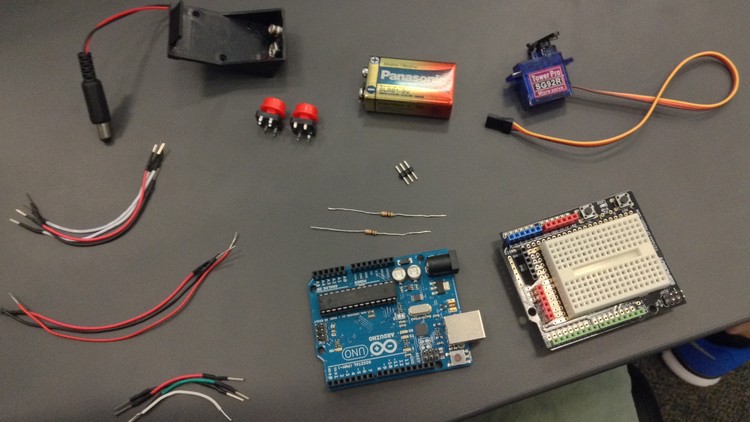Torrent details for "Udemy - Build 11 Arduino Practical Projects today! [Course Drive]" Log in to bookmark
Controls:
Language:
 English
EnglishTotal Size:
4.57 GB
Info Hash:
b2cde044a8ca3807f9403f105544a160cab63155
Added By:
Added:
22-04-2020 18:59
Views:
976
Health:

Seeds:
1
Leechers:
0
Completed:
126
Build 11 Arduino Practical Projects today!
Learn by Practicing real world Projects to apply everything you have learned

What you'll learn
• Connect different type of sensors and actuators to Arduino
• Interface different type of electronic elements with Arduino
• Use sensors and actuators to make useful projects
• Program, burn a code and wire Arduino
• Learn What are the right tools that you need to start making amazing projects
• Learn What makes a great Arduino Project
Requirements
• Basic Knowledge in Electronics Circuits
• Basic Knowledge in Circuit Design
• Basic Knowledge in C Language
• Basic Knowledge in Arduino
Description
>>> Learning by theory and Simulation is only half the answer, but connecting, wiring and burning a code to an actual Arduino, not a simulated one is the other more important half, and this is what we will cover in this course, you will learn by making Arduino Practical Projects. <<<
>>> Continues Updates <<<
More Than 55k STUDENT on All of our Courses!!! THANK YOU!!!
Welcome to this course.
• Learning By doing is what makes the difference between someone who learn and someone who applies what he learned
• In this course you will get the chance to see Arduino in Action, starting from simulation and moving forward to connecting the hardware and testing the code in real life.
• This will help you make sure your circuit works as expected and you can witness yourself building your first Arduino fully functional.
• The most important thing to note here is that when a circuit work with you in simulation, that doesn’t mean that it will work in real life, in more than 85% of the cases the simulated circuit doesn’t work when you connect it.
What is the best way to Learn, you ask?
• Learning by doing Arduino Practical Projects is the learn by practice approach that I prefer
• This approach allows you to not only master new Arduino skills but also gain practical knowledge along the way.
• Only a few people are satisfied with simulation, but if you want good results you must move on and hook up your circuit and test it out using real-life hardware parts.
• I'm trying to help you gain real world practical experience in Arduino, so let's start.
Arduino Motion Detector: Step By Step Guide
Make your own Arduino Motion Detector and start Catching Intruders, Control devices and lots more Cool Application
>>> This Course will show you how to build an Arduino Motion Detector Device that will Fire an Alarm once an Intruder is detected in a range of 6 to 7 meters, it will take you in a step by step manner to know what each component inside the device circuit is, and what it does and how to wire it up <<<
>>> Continues Updates <<<
4 Star | 1500 STUDENTS!!! THANK YOU!!!
What students are saying:
• Bobbie Smith says, "This course gives you excellent information and clear instructions on creating a motion detector. Thank you."
Welcome to this course.
You will know what is the actual working principle of Motion detectors that you see in banks and in door opining and closing mechanisms and what you can do with it and how to interface it with your own Arduino and make it execute and action using simple codes freely, you will no longer needs to buy a motion detector or customize it since you can make the device yourself.
After this course you will be able to make your own Motion detector and the choice is yours to use it in any application that comes in your mind and can make your life easier, since all connections are explained in details.
Goal From This Course:
- Connect a Motion Detector Sensor to Arduino Board with all necessary Components and make it work.
Required Materials
Hardware:
• Arduino or an Arduino clone board (freeduino), or you can make your own custom Arduino board.
• PIR Motion Sensor.
• A piezo buzzer or an 8-ohm speaker.
• 9V Battery and connector.
• Connecting wires.
Software:
• Arduino IDE
Arduino Radar: Step By Step Guide
Create your Own Radar using Arduino and get a Green Map Showing Objects at your own Screen in no time
>>> This course will take you in a step by step guide on how to make your own Radar using Arduino Board. <<<
>>> Continues Updates <<<
4 Star | More Than 3000 STUDENTS!!! THANK YOU!!!
What students are saying:
• Nathan Johnnie says, "As always Excellent! "
• Donald R. Lyons, Sr. says, "The course is concise and to the point. There is not a lot of wasted discussion."
Welcome to this course.
You will get to know how to wire each of these elements, how it works, and why we are using it inside this Project, in no time you will find yourself making your own Radar that shows different object and the distance between you and each object.
A Radar station is a device that collects data related to objects in the surronding environment using Ultrasonic sensors and a Servo motor to cover wider area.
The aim is to make a portable Radar Device
Features it should have
• Distance
• Angle
• Map that show different objects
You will wire sensors and motor to Arduino UNO board and start testing the code yourself, every piece of code is well explained so that you can easily know what each segment does.
A lot of information is waiting for you inside this course, join now and start making your own.
Arduino Web Control: Step By Step Guide
Make your own Arduino Web Control and start Controlling any device that you imagine using A Simple Webpage and Arduino
>>> This Course will teach you how to use a Web Page to Control anything using Arduino, This Guide will take you in a step by step manner to know what each component inside this circuit is, and what it does and how to wire it up, starting with the Ethernet shield and ending with resistors. <<<
>>> Continues Updates <<<
More than 5000 STUDENTS!!! THANK YOU!!!
What students are saying:
• Bobbie Smith says, "The instructor is thorough and concise. Thank you."
• Susi Kumar Prava says, "Great, Thank you"
• Kalid Al-ahmadi says, "I love It very nice"
Welcome to this course.
You will know what is the actual working principle of Ethernet shield and how to interface and configure it correctly so that you can access your Arduino Powered device from anywhere with an internet connection, and control any device with simple clicks in a webpage.
After this course, you will be able to make your own web controlled device and the choice is yours to use it in any application that comes in your mind and can make your life easier since all connections are explained in details.
We are going to control LEDs from a web page using an Arduino Ethernet module. The Ethernet module will create a server using the router and we will set a web page for this server.
We will use the HTML commands to print the data and to make the buttons on the web page.
When the button on the web page is pressed, we will get some data on the serial monitor. We will save this data in the string and will use this data to turn the LED’s ON or OFF.
Goal From Arduino Web Control Course:
- Connect Arduino Ethernet Shield to Arduino Board with all necessary Components and make it Internet Based.
What you will learn in this Course
- How to Connect an Ethernet Module to Arduino.
- The Right way to Detect Online Actions Using Arduino.
- The Working principle of Internet Control.
- How to interface different type of electronic elements with Arduino.
- How Arduino Can make your life easier.
- Program, burn a code and wire Arduino and Ethernet Module.
- Choose the right tools to start making amazing projects
- Why using Online control with Arduino is better than traditional Control Methods.
Automatic Weight Measuring Machine using Arduino
This guide will help you make Arduino Coin Operated Automatic Weight Measuring Machine in a Step by Step Manner
>>> Automatic Coin operated Weight Measuring Machine using Arduino <<<
>>> Continues Updates <<<
More Than 6000 STUDENTS!!! THANK YOU!!!
What students are saying:
• Rishab A says, "Excellent Course. I was able to complete the course in one go. Instructor was very clear on the concept. I have already ordered my hardware and I will complete the same very soon. Thanks for making this course. I would recommend this to all interested in making this project."
• Jiří Šustek says, "Good Course for Beginners"
Welcome to this course.
(Load Cell Interfacing with Arduino)
This guide will help you make Arduino Coin Operated Automatic Weight Measuring Machine in a Step by Step Manner
This Course will teach you how to Make your own Arduino Coin Operated Automatic Weight Measuring Machine and interface Load Cells with Arduino, This Guide will take you in a step by step manner to know what each component inside this circuit is, and what it does and how to wire it up, starting with the Load Cell Module and ending with resistors and Leds.
You will know what is the actual working principle of Load Cells and how to interface and configure it correctly so that you can read data from it and convert this data to weight in Grams, Ounces or Kilograms and display the output data on LCD, 7 Segment display or any other type of display of your choice
After this course you will be able to make your own Fully Functional Coin operated Automatic Weight Measuring Machine that you can place in any public place, to make passive income, or to use it to measure your own weight from time to time instead of buying a weight measuring machine
What you will learn in this Course
- How to make Arduino Coin Operated Automatic Weight Measuring Machine
- How to Deal with Load Cells Using Arduino.
- How to read data from Load Cell and display it on LCD or 7 Segment Display.
- How to interface different type of electronic elements with Arduino.
- How Arduino Can make your life easier.
- How to Program, burn a code and wire Arduino and Load Cell.
- What are the right tools that you need to start making amazing projects.
-This Course will cover how to use the circuits and codes to make passive income by creating a state of the art device that you can place in public places to gain money by offering automatic weight measuring service with this coin operated device.
Automatic Irrigation System with Arduino
Make your own Automatic Irrigation System and stop wasting time on checking your Soil manually and Start Automating Life
>>> This Course will teach you how to Make an Automatic Irrigation System with Arduino, This Guide will take you in a step by step manner to know what each component inside the system is, and what it does and how to wire it up, starting with the Soil Moisture Sensor, Nokia 5110 LCD Screen and ending with resistors. <<<
>>> Continues Updates <<<
More Than 3000 STUDENTS!!! THANK YOU!!!
What students are saying:
• Sunil Thakur says, "Excellent course for starting in Arduino especially for farm irrigation."
Welcome to this course.
You will know what is the actual working principle of Soil Moisture Sensor and how to interface and configure it correctly so that you can get accurate data with this Arduino Powered device and automate the Irrigation system.
After this course you will be able to make your own Automatic Irrigation System device and the choice is yours to use it or sell it or start a business, or do anything that comes in your mind, this will make your life easier, since all connections are explained in details.
Goal From This Course:
• Connect Arduino Ethernet Shield to Arduino Board with all necessary Components and make it Internet Based.
What you will learn in this Course
• How to connect Nokia 5110 LCD to Arduino.
• How to connect FC-28 Soil Moisture Sensor to Arduino.
• How to Detect Land condition Using Arduino.
• How Irrigation Process Actually Works.
• How to interface different type of electronic elements with Arduino.
• How Arduino Can make your life easier.
• How Program, burn a code and wire Arduino and Soil Moisture Sensor.
• What are the right tools that you need to start making amazing projects.
• Why control with Arduino is better than traditional Control Methods.
Arduino Weather Station: Step By Step Guide
Create your Own weather station using Arduino and get Temperature, Humidity and Time at your own home in no time
>>> This course will take you in a step by step guide on how to make your own Arduino Weather Station that can get Temperature, Humidity, Time and Date using LCD Crystal display and Arduino Board. <<<
>>> Continues Updates <<<
More Than 900 STUDENTS!!! THANK YOU!!!
What students are saying:
• Joan Davis says, "Very precise explanations. Proving resources for purchases help for planning the project. "
• Orven Bregu says, "Interesting course "
Welcome to Arduino Weather Station course.
You will get to know how to wire each of these elements, how it works, and why we are using it inside this weather station, in no time you will find your self-making your own station.
Arduino is a Microcontroller that enables a lot of geeks, students, and engineers to make great projects, turn any idea that comes in their mind to a real life fully functional device, and in this course, we are using it to make something useful and informative.
A weather station is a device that collects data related to the weather and environment using many different sensors, like humidity and temperature sensors, to get accurate results and display the outcome of these sensors on a display.
You will get to know and connect Sensors like
• Wind
• Humidity
• Rain
• Temperature
• Pressure
• Altitude
The aim is to make a portable weather station that you can take anywhere and use whenever you want to get accurate results on time, date and weather conditions
Features it will have
• Temperature
• Humidity
• Time and Date
You will wire sensors and LCD display to Arduino UNO board and start testing the code yourself, every piece of code is well explained so that you can easily know what each does, code and schematics will be explained in details.
A lot of information is waiting for you inside this course, join now and start making your own.
Arduino Multicolor RGB LED Lamp Controlled Using Bluetooth
In this Course You will learn How to Interface Arduino With a Mobile App via Bluetooth and Control RGB Multicolor Leds
>>> In this Course You will learn How to Interface Arduino With a Mobile App via Bluetooth and Control RGB Multicolor Leds <<<
>>> Continues Updates <<<
More Than 4000 STUDENTS!!! THANK YOU!!!
What students are saying:
• Eric Dion says, "I learn a lot about the Arduino bluetooth module in this course. The course is not very long but it is a good introduction to the Arduino bluetooth module."
Welcome to this course.
In this Course you will be introduced to Mobile Apps, Bluetooth Control, RGB Leds and how to interface all of these Items to get an amazing output that you can show to your friends and brag about it, this will really help you add something cool to your collection of projects that you already made, or even to your office.
Arduino Programming Courses online contains lots of unnecessary information that will surely distract beginners and make them feel odd when they first come to the Arduino World.
The instructor is a very high experienced hardware developer who has strong background in Arduino development, and made this course to help new comers to the Arduino world.
At first glance, RGB (Red, Green, Blue) LEDs look just like regular LEDs, however, inside the usual LED package, there are actually three LEDs, one red, one green and yes, one blue. By controlling the brightness of each of the individual LEDs you can mix pretty much any color you want.
We mix colors just like you would mix audio with a 'mixing board' or paint on a palette - by adjusting the brightness of each of the three LEDs.
Get ready to see Colors that you have never seen below.
No experience is required, and all you need is an Arduino and few simple electronic components
This course is designed for anyone interested in Arduino with zero background knowledge.
Arduino Bluetooth: Step BY Step Guide
Control Your World and Surrounding using Your Own smartphone in this Step by Step Guide that Will Make Your Life Easier
>>> This course will help you Control Your World using Tools that you already have which is Your Own smartphone to Make Your Life Easier, You can make any electronics device easily controlled by bringing it alive using Bluetooth Technology that you have in your phone and start playing with Arduino Bluetooth module interfacing in No Time. <<<
>>> Continues Updates <<<
More than 600 STUDENTS!!! THANK YOU!!!
Welcome to Arduino Bluetooth course.
You will get a step by step tutorial on what you need to do to get full control. In the end, you will be able to control any home appliance, project, car or any device using Bluetooth.
This is a course on interfacing Bluetooth module with Arduino. Eventually, It will give you the ability to make higher level Projects like Home automation using a smartphone, Smartphone controlled robot and much more.
You will know how to use the technology embedded in your phone. As a result, making your everyday life away much easier.
What is Bluetooth?
Bluetooth is a wireless technology standard for exchanging data over short distances (using short-wavelength UHF radio waves in the ISM band from 2.400 to 2.485 GHz) from fixed and mobile devices, and building personal area networks (PANs). Invented by Dutch electrical engineer Jaap Haartsen, working for telecom vendor Ericsson in 1994, it was originally conceived as a wireless alternative to RS-232 data cables.
Bluetooth is a standard wire-replacement communications protocol primarily designed for low power consumption. It has a short range based on low-cost transceiver microchips in each device. Because the devices use a radio (broadcast) communications system, they do not have to be in visual line of sight of each other. Range is power-class-dependent, but effective ranges vary in practice.
This course will help you:
• Start using Bluetooth Module with Arduino Board
• Kick-start communication using this amazing wireless technology.
Join this course now and start learning this awesome, must-know topic in the Arduino Field.
Arduino Wireless Power Transmission
Make your own Arduino Wireless Power Transmission Project and Learn the Principles behind Wireless Power
>>> Make your own Arduino Wireless Power Transmission Project and Learn the Principles behind Wireless Power <<<
>>> Continues Updates <<<
More Than 600 STUDENTS!!! THANK YOU!!!
What students are saying:
• Nathan Johnnie says, "Precise Course"
Welcome to this course.
This Course will teach you how to Make your own Arduino Wireless Power Transmission Project and light electronic components and devices with wireless power efficiently and effectively, This Guide will take you in a step by step manner to know what each component inside the wireless power transmission circuit is, and what it does and how to wire it up, starting with the winding coils and ending with things as simple as a resistor.
You will know what is the actual working principle of Wireless Power Transmission and how to use, interface and configure Arduino correctly so that you can make your own Arduino Wireless Power Transmission device.
After this course you will be able to make your own wireless power transmission device and the choice is yours to use it and apply it with any application that comes in your mind and I assure you that this can make your life easier, since all connections are explained in details.
Goal From This Course:
- Make your own Arduino Wireless Power Transmission Project and Learn the Principles behind Wireless Power
What you will learn in this Course
- How to Connect Arduino with other electronic components to turn it to a wireless power transmitter.
- How to interface different type of electronic elements with Arduino.
- How Arduino Can make your life easier.
- How to Program, burn a code and wire Arduino and Coils.
- What are the right tools that you need to start making amazing projects.
Arduino Alarm Clock Using a Real Time Clock and LCD Screen
Make your own Arduino Alarm Clock and set the Alarming time and interact with Time and Date efficiently and effectively
>>> Make your own Arduino Alarm Clock and set the Alarming time and interact with Time and Date efficiently and effectively <<<
>>> Continues Updates <<<
More Than 3900 STUDENTS!!! THANK YOU!!!
What students are saying:
• Orven Bregu says, "Project was explained into details. I've learned new things :)"
Welcome to this course.
This Course will teach you how to Make your own Arduino Alarm Clock and set the Alarming time and interact with Time and Date Variables efficiently and effectively, This Guide will take you in a step by step manner to know what each component inside this circuit is, and what it does and how to wire it up, starting with the RTC DS3231 Time and Date Module and ending with resistors.
You will know what is the actual working principle of RTC Module and how to interface and configure it correctly so that you can make your Arduino Powered alarm system, and view time and date in addition to initiate alarm action.
After this course you will be able to make your own Arduino Alarm Clock Using a Real Time Clock and LCD Screen and the choice is yours to use it and apply it with any application that comes in your mind and can make your life easier, since all connections are explained in details.
We are going to set the desired alarm time inside the code using an Arduino. The RTC Module will take care of the time and date values.
Goal From This Course:
- Make your own Arduino Alarm Clock and set the Alarming time and interact with Time and Date efficiently and effectively.
What you will learn in this Course
- How to Real Time Clock and LCD Screen to Arduino.
- How to Deal with Time and Date variables Using Arduino.
- How to set an AlAarm Action depending on the data that you take from RTC.
- How to interface different type of electronic elements with Arduino.
- How Arduino Can make your life easier.
- How Program, burn a code and wire Arduino and RTC Module.
- What are the right tools that you need to start making amazing projects.
Who this course is for:
• Anyone with a curiosity for making electronics
• Anyone wants to move from Simulation to Practical Work
• Anyone intersted in building real things
• People with no experience in electronics
• People with an intermediate knowledge of electronics
• Children over 14 years old
Learn by Practicing real world Projects to apply everything you have learned

What you'll learn
• Connect different type of sensors and actuators to Arduino
• Interface different type of electronic elements with Arduino
• Use sensors and actuators to make useful projects
• Program, burn a code and wire Arduino
• Learn What are the right tools that you need to start making amazing projects
• Learn What makes a great Arduino Project
Requirements
• Basic Knowledge in Electronics Circuits
• Basic Knowledge in Circuit Design
• Basic Knowledge in C Language
• Basic Knowledge in Arduino
Description
>>> Learning by theory and Simulation is only half the answer, but connecting, wiring and burning a code to an actual Arduino, not a simulated one is the other more important half, and this is what we will cover in this course, you will learn by making Arduino Practical Projects. <<<
>>> Continues Updates <<<
More Than 55k STUDENT on All of our Courses!!! THANK YOU!!!
Welcome to this course.
• Learning By doing is what makes the difference between someone who learn and someone who applies what he learned
• In this course you will get the chance to see Arduino in Action, starting from simulation and moving forward to connecting the hardware and testing the code in real life.
• This will help you make sure your circuit works as expected and you can witness yourself building your first Arduino fully functional.
• The most important thing to note here is that when a circuit work with you in simulation, that doesn’t mean that it will work in real life, in more than 85% of the cases the simulated circuit doesn’t work when you connect it.
What is the best way to Learn, you ask?
• Learning by doing Arduino Practical Projects is the learn by practice approach that I prefer
• This approach allows you to not only master new Arduino skills but also gain practical knowledge along the way.
• Only a few people are satisfied with simulation, but if you want good results you must move on and hook up your circuit and test it out using real-life hardware parts.
• I'm trying to help you gain real world practical experience in Arduino, so let's start.
Arduino Motion Detector: Step By Step Guide
Make your own Arduino Motion Detector and start Catching Intruders, Control devices and lots more Cool Application
>>> This Course will show you how to build an Arduino Motion Detector Device that will Fire an Alarm once an Intruder is detected in a range of 6 to 7 meters, it will take you in a step by step manner to know what each component inside the device circuit is, and what it does and how to wire it up <<<
>>> Continues Updates <<<
4 Star | 1500 STUDENTS!!! THANK YOU!!!
What students are saying:
• Bobbie Smith says, "This course gives you excellent information and clear instructions on creating a motion detector. Thank you."
Welcome to this course.
You will know what is the actual working principle of Motion detectors that you see in banks and in door opining and closing mechanisms and what you can do with it and how to interface it with your own Arduino and make it execute and action using simple codes freely, you will no longer needs to buy a motion detector or customize it since you can make the device yourself.
After this course you will be able to make your own Motion detector and the choice is yours to use it in any application that comes in your mind and can make your life easier, since all connections are explained in details.
Goal From This Course:
- Connect a Motion Detector Sensor to Arduino Board with all necessary Components and make it work.
Required Materials
Hardware:
• Arduino or an Arduino clone board (freeduino), or you can make your own custom Arduino board.
• PIR Motion Sensor.
• A piezo buzzer or an 8-ohm speaker.
• 9V Battery and connector.
• Connecting wires.
Software:
• Arduino IDE
Arduino Radar: Step By Step Guide
Create your Own Radar using Arduino and get a Green Map Showing Objects at your own Screen in no time
>>> This course will take you in a step by step guide on how to make your own Radar using Arduino Board. <<<
>>> Continues Updates <<<
4 Star | More Than 3000 STUDENTS!!! THANK YOU!!!
What students are saying:
• Nathan Johnnie says, "As always Excellent! "
• Donald R. Lyons, Sr. says, "The course is concise and to the point. There is not a lot of wasted discussion."
Welcome to this course.
You will get to know how to wire each of these elements, how it works, and why we are using it inside this Project, in no time you will find yourself making your own Radar that shows different object and the distance between you and each object.
A Radar station is a device that collects data related to objects in the surronding environment using Ultrasonic sensors and a Servo motor to cover wider area.
The aim is to make a portable Radar Device
Features it should have
• Distance
• Angle
• Map that show different objects
You will wire sensors and motor to Arduino UNO board and start testing the code yourself, every piece of code is well explained so that you can easily know what each segment does.
A lot of information is waiting for you inside this course, join now and start making your own.
Arduino Web Control: Step By Step Guide
Make your own Arduino Web Control and start Controlling any device that you imagine using A Simple Webpage and Arduino
>>> This Course will teach you how to use a Web Page to Control anything using Arduino, This Guide will take you in a step by step manner to know what each component inside this circuit is, and what it does and how to wire it up, starting with the Ethernet shield and ending with resistors. <<<
>>> Continues Updates <<<
More than 5000 STUDENTS!!! THANK YOU!!!
What students are saying:
• Bobbie Smith says, "The instructor is thorough and concise. Thank you."
• Susi Kumar Prava says, "Great, Thank you"
• Kalid Al-ahmadi says, "I love It very nice"
Welcome to this course.
You will know what is the actual working principle of Ethernet shield and how to interface and configure it correctly so that you can access your Arduino Powered device from anywhere with an internet connection, and control any device with simple clicks in a webpage.
After this course, you will be able to make your own web controlled device and the choice is yours to use it in any application that comes in your mind and can make your life easier since all connections are explained in details.
We are going to control LEDs from a web page using an Arduino Ethernet module. The Ethernet module will create a server using the router and we will set a web page for this server.
We will use the HTML commands to print the data and to make the buttons on the web page.
When the button on the web page is pressed, we will get some data on the serial monitor. We will save this data in the string and will use this data to turn the LED’s ON or OFF.
Goal From Arduino Web Control Course:
- Connect Arduino Ethernet Shield to Arduino Board with all necessary Components and make it Internet Based.
What you will learn in this Course
- How to Connect an Ethernet Module to Arduino.
- The Right way to Detect Online Actions Using Arduino.
- The Working principle of Internet Control.
- How to interface different type of electronic elements with Arduino.
- How Arduino Can make your life easier.
- Program, burn a code and wire Arduino and Ethernet Module.
- Choose the right tools to start making amazing projects
- Why using Online control with Arduino is better than traditional Control Methods.
Automatic Weight Measuring Machine using Arduino
This guide will help you make Arduino Coin Operated Automatic Weight Measuring Machine in a Step by Step Manner
>>> Automatic Coin operated Weight Measuring Machine using Arduino <<<
>>> Continues Updates <<<
More Than 6000 STUDENTS!!! THANK YOU!!!
What students are saying:
• Rishab A says, "Excellent Course. I was able to complete the course in one go. Instructor was very clear on the concept. I have already ordered my hardware and I will complete the same very soon. Thanks for making this course. I would recommend this to all interested in making this project."
• Jiří Šustek says, "Good Course for Beginners"
Welcome to this course.
(Load Cell Interfacing with Arduino)
This guide will help you make Arduino Coin Operated Automatic Weight Measuring Machine in a Step by Step Manner
This Course will teach you how to Make your own Arduino Coin Operated Automatic Weight Measuring Machine and interface Load Cells with Arduino, This Guide will take you in a step by step manner to know what each component inside this circuit is, and what it does and how to wire it up, starting with the Load Cell Module and ending with resistors and Leds.
You will know what is the actual working principle of Load Cells and how to interface and configure it correctly so that you can read data from it and convert this data to weight in Grams, Ounces or Kilograms and display the output data on LCD, 7 Segment display or any other type of display of your choice
After this course you will be able to make your own Fully Functional Coin operated Automatic Weight Measuring Machine that you can place in any public place, to make passive income, or to use it to measure your own weight from time to time instead of buying a weight measuring machine
What you will learn in this Course
- How to make Arduino Coin Operated Automatic Weight Measuring Machine
- How to Deal with Load Cells Using Arduino.
- How to read data from Load Cell and display it on LCD or 7 Segment Display.
- How to interface different type of electronic elements with Arduino.
- How Arduino Can make your life easier.
- How to Program, burn a code and wire Arduino and Load Cell.
- What are the right tools that you need to start making amazing projects.
-This Course will cover how to use the circuits and codes to make passive income by creating a state of the art device that you can place in public places to gain money by offering automatic weight measuring service with this coin operated device.
Automatic Irrigation System with Arduino
Make your own Automatic Irrigation System and stop wasting time on checking your Soil manually and Start Automating Life
>>> This Course will teach you how to Make an Automatic Irrigation System with Arduino, This Guide will take you in a step by step manner to know what each component inside the system is, and what it does and how to wire it up, starting with the Soil Moisture Sensor, Nokia 5110 LCD Screen and ending with resistors. <<<
>>> Continues Updates <<<
More Than 3000 STUDENTS!!! THANK YOU!!!
What students are saying:
• Sunil Thakur says, "Excellent course for starting in Arduino especially for farm irrigation."
Welcome to this course.
You will know what is the actual working principle of Soil Moisture Sensor and how to interface and configure it correctly so that you can get accurate data with this Arduino Powered device and automate the Irrigation system.
After this course you will be able to make your own Automatic Irrigation System device and the choice is yours to use it or sell it or start a business, or do anything that comes in your mind, this will make your life easier, since all connections are explained in details.
Goal From This Course:
• Connect Arduino Ethernet Shield to Arduino Board with all necessary Components and make it Internet Based.
What you will learn in this Course
• How to connect Nokia 5110 LCD to Arduino.
• How to connect FC-28 Soil Moisture Sensor to Arduino.
• How to Detect Land condition Using Arduino.
• How Irrigation Process Actually Works.
• How to interface different type of electronic elements with Arduino.
• How Arduino Can make your life easier.
• How Program, burn a code and wire Arduino and Soil Moisture Sensor.
• What are the right tools that you need to start making amazing projects.
• Why control with Arduino is better than traditional Control Methods.
Arduino Weather Station: Step By Step Guide
Create your Own weather station using Arduino and get Temperature, Humidity and Time at your own home in no time
>>> This course will take you in a step by step guide on how to make your own Arduino Weather Station that can get Temperature, Humidity, Time and Date using LCD Crystal display and Arduino Board. <<<
>>> Continues Updates <<<
More Than 900 STUDENTS!!! THANK YOU!!!
What students are saying:
• Joan Davis says, "Very precise explanations. Proving resources for purchases help for planning the project. "
• Orven Bregu says, "Interesting course "
Welcome to Arduino Weather Station course.
You will get to know how to wire each of these elements, how it works, and why we are using it inside this weather station, in no time you will find your self-making your own station.
Arduino is a Microcontroller that enables a lot of geeks, students, and engineers to make great projects, turn any idea that comes in their mind to a real life fully functional device, and in this course, we are using it to make something useful and informative.
A weather station is a device that collects data related to the weather and environment using many different sensors, like humidity and temperature sensors, to get accurate results and display the outcome of these sensors on a display.
You will get to know and connect Sensors like
• Wind
• Humidity
• Rain
• Temperature
• Pressure
• Altitude
The aim is to make a portable weather station that you can take anywhere and use whenever you want to get accurate results on time, date and weather conditions
Features it will have
• Temperature
• Humidity
• Time and Date
You will wire sensors and LCD display to Arduino UNO board and start testing the code yourself, every piece of code is well explained so that you can easily know what each does, code and schematics will be explained in details.
A lot of information is waiting for you inside this course, join now and start making your own.
Arduino Multicolor RGB LED Lamp Controlled Using Bluetooth
In this Course You will learn How to Interface Arduino With a Mobile App via Bluetooth and Control RGB Multicolor Leds
>>> In this Course You will learn How to Interface Arduino With a Mobile App via Bluetooth and Control RGB Multicolor Leds <<<
>>> Continues Updates <<<
More Than 4000 STUDENTS!!! THANK YOU!!!
What students are saying:
• Eric Dion says, "I learn a lot about the Arduino bluetooth module in this course. The course is not very long but it is a good introduction to the Arduino bluetooth module."
Welcome to this course.
In this Course you will be introduced to Mobile Apps, Bluetooth Control, RGB Leds and how to interface all of these Items to get an amazing output that you can show to your friends and brag about it, this will really help you add something cool to your collection of projects that you already made, or even to your office.
Arduino Programming Courses online contains lots of unnecessary information that will surely distract beginners and make them feel odd when they first come to the Arduino World.
The instructor is a very high experienced hardware developer who has strong background in Arduino development, and made this course to help new comers to the Arduino world.
At first glance, RGB (Red, Green, Blue) LEDs look just like regular LEDs, however, inside the usual LED package, there are actually three LEDs, one red, one green and yes, one blue. By controlling the brightness of each of the individual LEDs you can mix pretty much any color you want.
We mix colors just like you would mix audio with a 'mixing board' or paint on a palette - by adjusting the brightness of each of the three LEDs.
Get ready to see Colors that you have never seen below.
No experience is required, and all you need is an Arduino and few simple electronic components
This course is designed for anyone interested in Arduino with zero background knowledge.
Arduino Bluetooth: Step BY Step Guide
Control Your World and Surrounding using Your Own smartphone in this Step by Step Guide that Will Make Your Life Easier
>>> This course will help you Control Your World using Tools that you already have which is Your Own smartphone to Make Your Life Easier, You can make any electronics device easily controlled by bringing it alive using Bluetooth Technology that you have in your phone and start playing with Arduino Bluetooth module interfacing in No Time. <<<
>>> Continues Updates <<<
More than 600 STUDENTS!!! THANK YOU!!!
Welcome to Arduino Bluetooth course.
You will get a step by step tutorial on what you need to do to get full control. In the end, you will be able to control any home appliance, project, car or any device using Bluetooth.
This is a course on interfacing Bluetooth module with Arduino. Eventually, It will give you the ability to make higher level Projects like Home automation using a smartphone, Smartphone controlled robot and much more.
You will know how to use the technology embedded in your phone. As a result, making your everyday life away much easier.
What is Bluetooth?
Bluetooth is a wireless technology standard for exchanging data over short distances (using short-wavelength UHF radio waves in the ISM band from 2.400 to 2.485 GHz) from fixed and mobile devices, and building personal area networks (PANs). Invented by Dutch electrical engineer Jaap Haartsen, working for telecom vendor Ericsson in 1994, it was originally conceived as a wireless alternative to RS-232 data cables.
Bluetooth is a standard wire-replacement communications protocol primarily designed for low power consumption. It has a short range based on low-cost transceiver microchips in each device. Because the devices use a radio (broadcast) communications system, they do not have to be in visual line of sight of each other. Range is power-class-dependent, but effective ranges vary in practice.
This course will help you:
• Start using Bluetooth Module with Arduino Board
• Kick-start communication using this amazing wireless technology.
Join this course now and start learning this awesome, must-know topic in the Arduino Field.
Arduino Wireless Power Transmission
Make your own Arduino Wireless Power Transmission Project and Learn the Principles behind Wireless Power
>>> Make your own Arduino Wireless Power Transmission Project and Learn the Principles behind Wireless Power <<<
>>> Continues Updates <<<
More Than 600 STUDENTS!!! THANK YOU!!!
What students are saying:
• Nathan Johnnie says, "Precise Course"
Welcome to this course.
This Course will teach you how to Make your own Arduino Wireless Power Transmission Project and light electronic components and devices with wireless power efficiently and effectively, This Guide will take you in a step by step manner to know what each component inside the wireless power transmission circuit is, and what it does and how to wire it up, starting with the winding coils and ending with things as simple as a resistor.
You will know what is the actual working principle of Wireless Power Transmission and how to use, interface and configure Arduino correctly so that you can make your own Arduino Wireless Power Transmission device.
After this course you will be able to make your own wireless power transmission device and the choice is yours to use it and apply it with any application that comes in your mind and I assure you that this can make your life easier, since all connections are explained in details.
Goal From This Course:
- Make your own Arduino Wireless Power Transmission Project and Learn the Principles behind Wireless Power
What you will learn in this Course
- How to Connect Arduino with other electronic components to turn it to a wireless power transmitter.
- How to interface different type of electronic elements with Arduino.
- How Arduino Can make your life easier.
- How to Program, burn a code and wire Arduino and Coils.
- What are the right tools that you need to start making amazing projects.
Arduino Alarm Clock Using a Real Time Clock and LCD Screen
Make your own Arduino Alarm Clock and set the Alarming time and interact with Time and Date efficiently and effectively
>>> Make your own Arduino Alarm Clock and set the Alarming time and interact with Time and Date efficiently and effectively <<<
>>> Continues Updates <<<
More Than 3900 STUDENTS!!! THANK YOU!!!
What students are saying:
• Orven Bregu says, "Project was explained into details. I've learned new things :)"
Welcome to this course.
This Course will teach you how to Make your own Arduino Alarm Clock and set the Alarming time and interact with Time and Date Variables efficiently and effectively, This Guide will take you in a step by step manner to know what each component inside this circuit is, and what it does and how to wire it up, starting with the RTC DS3231 Time and Date Module and ending with resistors.
You will know what is the actual working principle of RTC Module and how to interface and configure it correctly so that you can make your Arduino Powered alarm system, and view time and date in addition to initiate alarm action.
After this course you will be able to make your own Arduino Alarm Clock Using a Real Time Clock and LCD Screen and the choice is yours to use it and apply it with any application that comes in your mind and can make your life easier, since all connections are explained in details.
We are going to set the desired alarm time inside the code using an Arduino. The RTC Module will take care of the time and date values.
Goal From This Course:
- Make your own Arduino Alarm Clock and set the Alarming time and interact with Time and Date efficiently and effectively.
What you will learn in this Course
- How to Real Time Clock and LCD Screen to Arduino.
- How to Deal with Time and Date variables Using Arduino.
- How to set an AlAarm Action depending on the data that you take from RTC.
- How to interface different type of electronic elements with Arduino.
- How Arduino Can make your life easier.
- How Program, burn a code and wire Arduino and RTC Module.
- What are the right tools that you need to start making amazing projects.
Who this course is for:
• Anyone with a curiosity for making electronics
• Anyone wants to move from Simulation to Practical Work
• Anyone intersted in building real things
• People with no experience in electronics
• People with an intermediate knowledge of electronics
• Children over 14 years old











































